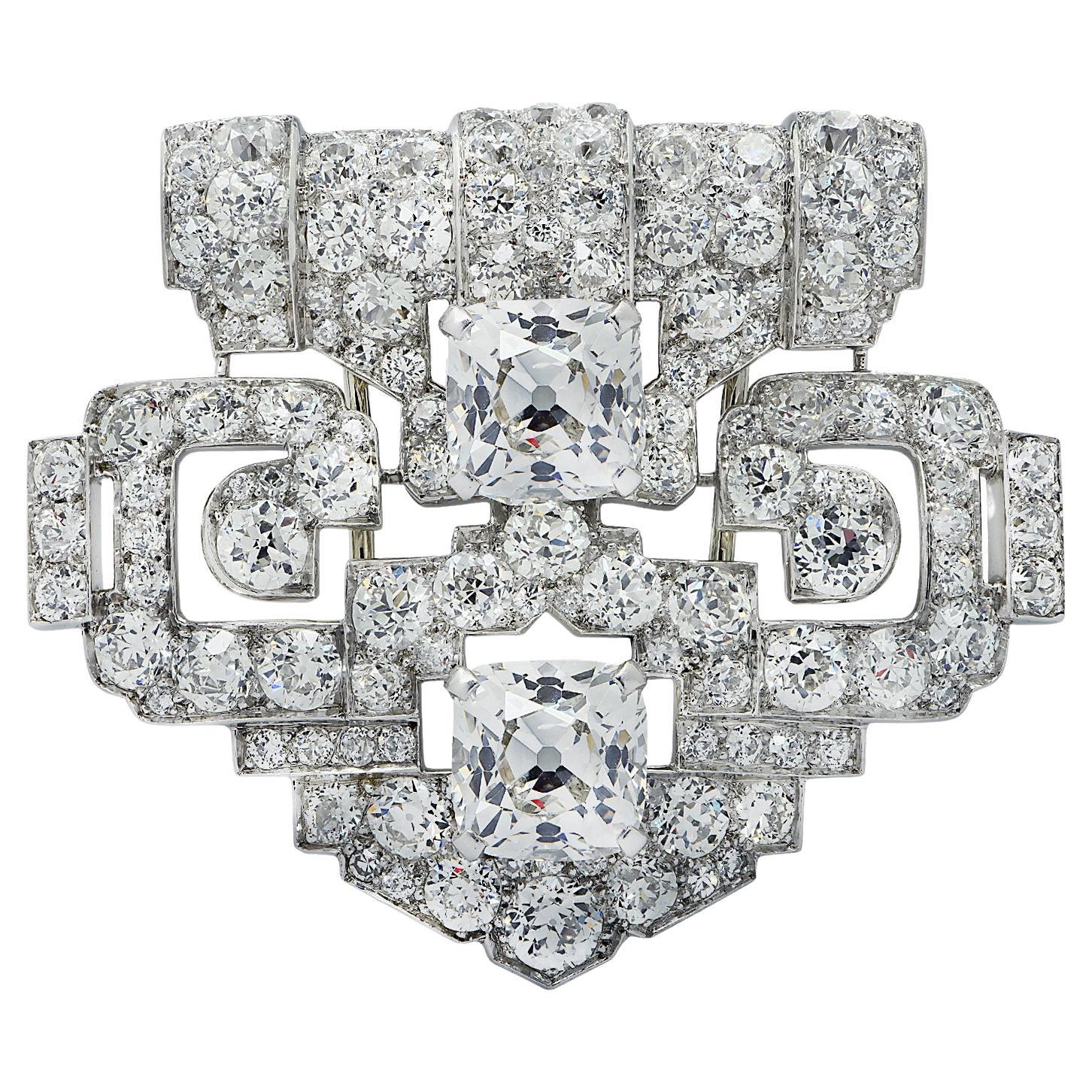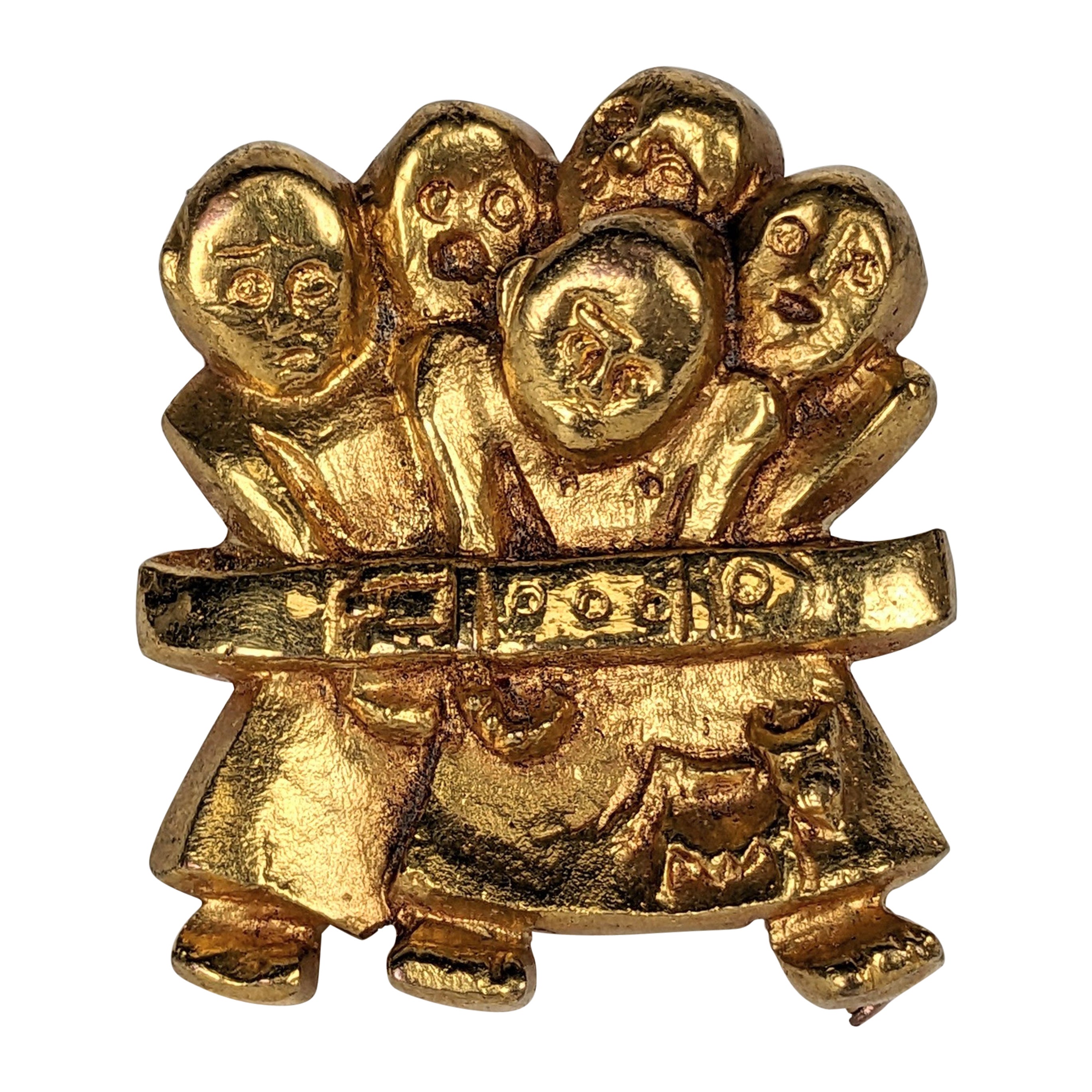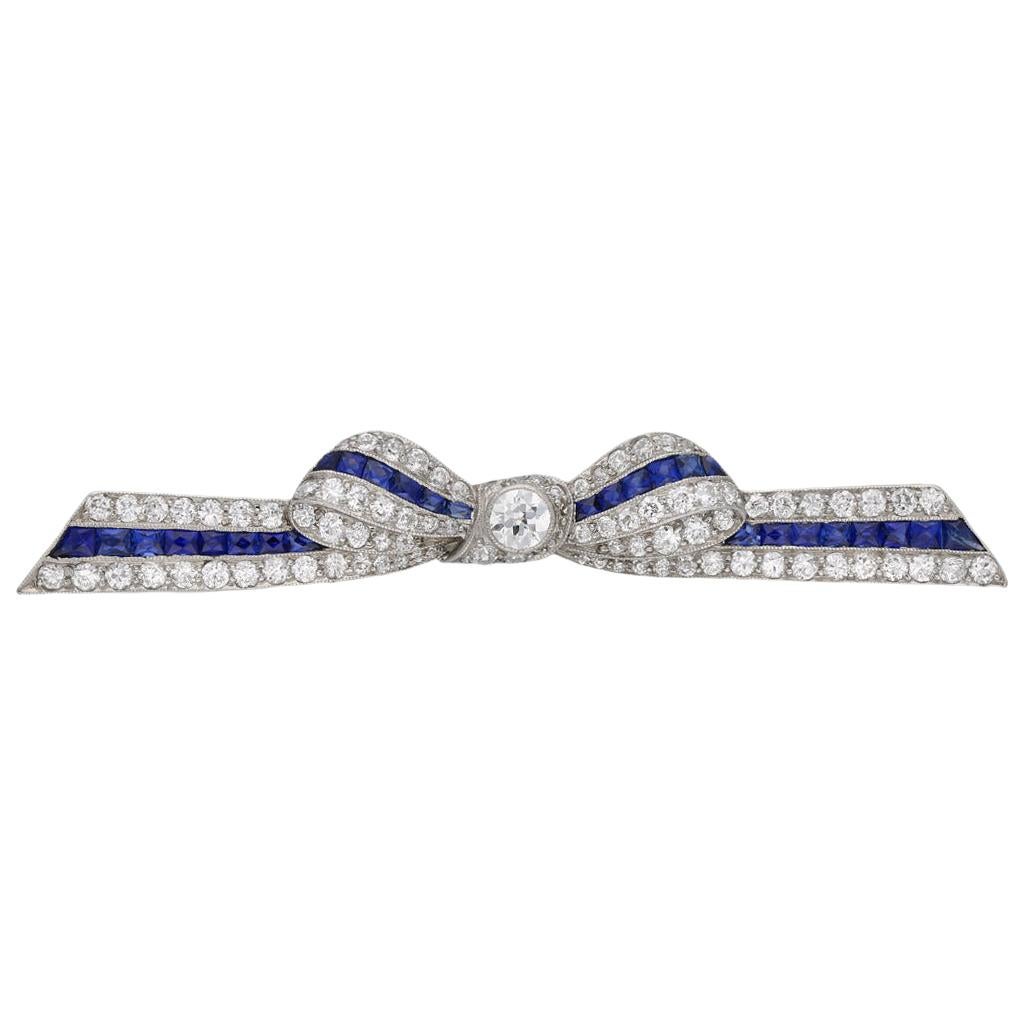Hermès 18k Gold Knot Vintage Brooch
About the Item
- Creator:
- Metal:18k Gold
- Weight:19.6 g
- Dimensions:Width: 1.25 in (31.75 mm)Diameter: 1 in (25.4 mm)Length: 1 in (25.4 mm)
- Place of Origin:France
- Period:Late 20th Century
- Date of Manufacture:1990
- Condition:Wear consistent with age and use.
- Seller Location:Beverly Hills, CA
- Reference Number:
Hermès
For Hermès, what began as a maker of leather equestrian goods for European noblemen would eventually grow into one of the most storied fashion labels in the world. In 1837, German-born French entrepreneur Thierry Hermès opened a saddle and harness purveyor in Paris. Gradually, the house extended into accessories and luggage for its riders, and today, in paying homage to its origins, the family-run luxury brand resurfaces horse motifs in everything from clothing and modernist jewelry to pillows and handbags.
The first top-handled bag ever produced by Hermès was the Haut à courroies, which made its debut in 1892. A tall bag secured with a folded leather flap (fastened with bridle-inspired straps), it was designed to transport riding boots and a harness.
As the world made the switch from horse to automobile, the bag adapted, becoming a multifunctional travel satchel instead of a designated saddlebag. Today, 120 years later, the HAC remains in Hermès’s line — and its distinctive flap and clasping straps have laid the groundwork for some of the house’s other iconic bags.
In the 1930s, Robert Dumas (son-in-law to Émile-Maurice Hermès, Thierry’s grandson) designed a smaller, trapezoidal take on the flap bag with a handle and two side straps. Later, actress Grace Kelly, then engaged to Prince Rainier of Monaco, is said to have used one of these bags to conceal her pregnancy during the 1950s. Because she was photographed constantly, the coverage catapulted her handbag to international popularity.
In 1977, Hermès officially renamed the model for her, and the Kelly bag was born. Each Kelly bag takes between 18 and 25 hours to produce, and its 680 hand stitches owe solely to one Hermès artisan.
Robert Dumas was also responsible for another one of the brand’s most iconic offerings: the launch of its first silk scarf on the occasion of Hermès’s 100th anniversary in 1937. Based on a woodblock designed by Dumas and printed on Chinese silk, the accessory was an immediate hit.
Today, vintage Hermès scarves, typically adorned in rich colors and elaborate patterns, serve many functions, just as they did back then. Well-heeled women wear it on their heads, around their necks and, in a genius piece of cross-promotion, tied to the straps of their Hermès bags. Kelly even once used one as a sling for her broken arm.
In 1981, Robert Dumas’s son Jean-Louis Dumas, then Hermès chairman, found himself sitting next to French actress and musician Jane Birkin on a plane, where she was complaining about finding a suitable carryall for the necessary accoutrements of motherhood. After the two travelers were properly introduced, Birkin helped design Jean-Louis’s most famous contribution to the Hermès canon: the Birkin bag, a roomy, square catchall with the HAC’s trademark leather flap top and the addition of a lock and key.
Owing to the brand’s legendary commitment to deft, handcrafted construction, the Birkin is an investment that is coveted by collectors everywhere.
While the Kelly and Birkin may be standouts, gracing the arms of everyone from royal heiresses to hip-hop stars in the past few decades, the handbags are but a small part of Hermès’s fashion offerings.
Since the 1920s, the brand has produced some of the most desirable leather goods in the world. There’s the Constance bag, a favorite of Jacqueline Kennedy, the recently relaunched 1970s-era Evelyne and, on the vintage market, a slew of designs dating back to the 1920s.
Good design never goes out of style. Find a variety of vintage Hermès handbags, day dresses, shoes and more on 1stDibs.
- ShippingRetrieving quote...Ships From: Beverly Hills, CA
- Return PolicyA return for this item may be initiated within 3 days of delivery.
- French Vintage Turtle Brooch 18k Gold RubyLocated in Beverly Hills, CAA cute French vintage turtle brooch made of 18k gold, features ruby. This amazing pin was meticulously made by skillfully applying multiple goldsmith te...Category
Vintage 1970s French Brooches
MaterialsRuby, Gold, 18k Gold
- Vintage Bulgari 18K Yellow Gold, Citrine, Pearl & Diamond Pin BroochBy BulgariLocated in Beverly Hills, CA- 18 karat yellow gold - 13.48 carat of square cut citrine - 0.18 carat of round brilliant cut diamond - 5- 7.5mm of white round cultured pearls - D...Category
Late 20th Century Brooches
MaterialsCitrine, Diamond, Pearl, 18k Gold, Yellow Gold
- Vintage Yellow Gold Oval Link Chain Necklace w/ Pendant & BroochLocated in Beverly Hills, CAProduct details: The necklace and the brooch made out of 18 karat yellow gold, featuring textured finish and floral motif. The necklace is 34 inches long and 5/16 inches wide. The ...Category
Late 20th Century Chain Necklaces
Materials18k Gold, Yellow Gold
- Vintage David Webb Diamond & Enamel Bow Ribbon Pin BroochBy David WebbLocated in Beverly Hills, CA- 18 karat yellow gold - 900 platinum - 2.50 carat of round brilliant cut diamonds - Blue and green enamel - Double clip - Comes with certificate of authenticity - Style number: 091...Category
20th Century Brooches
MaterialsDiamond, Enamel
- Mellerio Retro Yellow and White 18k Gold Diamond Ruby BroochBy Mellerio dits MellerLocated in Beverly Hills, CADESIGNER: Mellerio dits Meller CIRCA: 1950s MATERIALS: 18K Gold GEMSTONE: Round Brilliant Cut Diamonds GEMSTONE 2: Ruby WEIGHT: 21 grams MEASUREMENTS: 1 1/4” x 1 3/8” HALLMARKS: M...Category
Mid-20th Century French Brooches
MaterialsDiamond, Ruby, Gold
- Vintage Parrot Brooch 14k Gold Diamond EnamelLocated in Beverly Hills, CACIRCA: 1970s MATERIALS: 14k Yellow Gold GEMSTONE: Round Brilliant Cut Diamonds WEIGHT: 12.2 grams MEASUREMENTS: 1 1/4” x 5/8” HALLMARKS: 14K A colorful vintage parrot brooch...Category
Late 20th Century Unknown Brooches
MaterialsDiamond, 14k Gold, Enamel
- Cartier New York GIA Certified 11.24 Carat Old Mine Cushion Diamond BroochBy CartierLocated in Miami, FLMagnificent Cartier Art Deco Platinum and Diamond Brooch featuring a matching pair of important Old Mine Cut Diamonds weighing 5.60 carats and 5.64 carats. Both accompanied by a GIA report stating that they are H color VS1 and H color VS2 clarity. This brooch comes with an Expertise letter from IAJA (international Antique Jewelers...Category
Vintage 1930s American Art Deco Brooches
MaterialsDiamond, Platinum
- Carved Coral Buddha Pendant in 18k Gold Set with Diamonds, Emeralds and RubiesLocated in Honolulu, HIMAGNIFICENT large vintage Buddha pendant brooch in 18K yellow gold. This gorgeous pendant features a stunning Buddha carved in natural coral set...Category
Late 20th Century Unknown Pendant Necklaces
MaterialsCoral, Diamond, Emerald, Ruby, 18k Gold
- Line Vautrin "La Manif" Gilt Bronze BroochBy Line VautrinLocated in New York, NYGilt brooch by Line Vautrin (1913-1997), circa 1945-46. The design is known as ...Category
Vintage 1950s French Artisan Brooches
MaterialsBronze, Gilt Metal, Gold Plate, Brass
- Vintage Ruby Onyx and Diamond Classic Car BroochLocated in London, GBHere we have a superb vintage brooch. The piece has been crafted from 18ct yellow gold into the shape of a classic car from the 1930s. Automobiles of the 1930s exhibited many notable...Category
Vintage 1930s Brooches
MaterialsDiamond, Onyx, Ruby, Gold, Yellow Gold, Enamel
- Marcus & Co. Sapphire and Diamond Bow Brooch, American, circa 1935Located in London, GBSapphire and diamond bow brooch by Marcus & Co, American, circa 1935. A yellow gold and platinum bow form brooch set with one central row of twenty eig...Category
Vintage 1930s American Art Deco Brooches
MaterialsDiamond, Sapphire, Platinum
- John Brogden Shell Cameo Brooch and Earrings, English, circa 1870By John BrogdenLocated in London, GBAntique shell cameo brooch and earrings by John Brogden, English, circa 1870. A yellow gold suite of jewellery, the brooch composed of a horizontally situated oval Bull’s Mouth shell cameo of the Greek goddess Selene riding a serpentine dragon in a rubover collet setting, encircled by a conforming frame of gold beading and twisted gold wire punctuated with four gold palmette form plaques engraved and decorated with dark blue enamel and placed at the cardinal points, the reverse mounted with a hinged pin and scroll clasp, the earrings each composed of a vertical oval Bull’s Mouth shell cameo engraved with a bust length portrait of Selene with crescent-set headdress, encircled by a conforming frame matching that of the brooch with the addition of a pendant decoration composed of a horizontal bar of gold beading and twisted gold wires suspending gold link chains graduated from centre and ending in conical gold elements, the reverses mounted with French wire fittings, all in a fitted red leather case, the interior marked ‘FIRST CLASS PARIS MEDAL/ 1855.1867.1851/ PARIS FIRST CLASS & LONDON PRIZE MEDALS/ JOHN BROGDON/ Goldsmith/ MANUFACTORY/ 16, Henrietta St. Covent Garden/ London’. The cameo—defined as a gem, usually either a mineral or a shell, upon which a design has been carved in relief—is believed to have originated in Hellenistic Greece, during the third century BC. These miniature sculptures, at that time confined to the medium of hardstone, are thought to have been made with the primary purpose of personal adornment. The same practice of mounting cameos in jewellery was then continued by the Ancient Romans, and they are known to have been worn by many a Roman emperor. After the fall of Rome the fashion for cameos went into a decline, until it was again revived during the Renaissance period, brought about by a keen interest in the ancient world. At this time both antique and contemporary cameos were mounted in jewellery, as well as collected as objet d’art. The art of cameo cutting was revived in Italy, where it would remain a centre for the coming centuries. Again there was a lull in interest in carved gemstones, until the Neoclassical revival of the eighteenth century, largely stimulated by the discoveries of the ancient Roman cities of Pompeii and Herculaneum. As with the Renaissance, antique specimens were generally prized over modern cameos, and the worldliest men in Europe held them among their collections of art and antiques. That said, carving centres in Rome and Torre del Greco (near Naples) in Italy were established in response to the demand of the Grand Tourists, who travelled to Italy and Greece to become educated in the wonders of the ancient world. It was at this time that shell cameos, mostly made in Torre del Greco due to its proximity to the sea, became more popular, owing to the relative ease in carving shell over hardstone. In addition to Rome, hardstone cameos also became a specialty of Idar Oberstein, Germany, which had a long history with both the gem mining and cutting trade. In a shift away from the collector’s cases of the previous century, the nineteenth century saw a strengthening in the fashion for wearable cameos. After the Empress Josephine donned a cameo-set suite of jewellery at the coronation of Napoleon in 1804, cameo jewellery became all the rage. Napoleon played a further hand in promoting the art by establishing a gemstone carving school in Paris, inspired by his appreciation for the arts of the ancient world. By the mid-nineteenth century shell cameos, in part due to their lightness compared with hardstone cameos, were the height of fashion. Large shell cameos as well as hardstone cameos were set into contemporary mounts, often as suites of jewellery. Some of the best cameos of the nineteenth century—carved by a select group of recognized carvers—were set into revivalist mounts, corresponding to the subject matter. In Victorian England cameo jewellery was particularly prized, due in part to the fact that the Queen owned and wore a number of cameo jewels. One example which can often be seen in official portraits is the Badge of the Order of Victoria and Albert, carved by Tommaso Saulini of Rome, who also produced cameos for the maker of the present suite, John Brogden. To meet demand some carvers set themselves up in London, including William Schmidt, a German carver from Idar Oberstein, who produced cameos for top London jewellers, including Brogden, Carlo Giuliano and Child & Child. In fact, Schmidt purports to have been the first to carve cameos out of opal, which Brogden reportedly displayed in the Paris Exhibition of 1878. An extant example, now in the collection of the British Museum, was set by the Giuliano firm. Regarding subject matter, cameos throughout time have been largely figural, from bust length profile portraits to scenes with multiple full-length figures, and sometimes animals. Ancient Greek and Roman cameos often depicted mythological scenes as well as contemporary figures. During the Renaissance, mythological scenes were popular, often taken directly from ancient sculpture, as well as portraits of notable contemporary figures. During the eighteenth and nineteenth centuries, due to the revivalist styles, both Renaissance and Classical subjects were copied and set into matching (and sometimes unmatching) revivalist mounts. From the Renaissance through the Victorian era, being able to recognize the source of the carving in a cameo was a mark of erudition, revealing in the wearer knowledge of Classical art. As mentioned, the present cameo parure...Category
Antique 1870s English Victorian Brooches
MaterialsYellow Gold
Recently Viewed
View AllRead More
The Hermès Passe-Guide Bag Might Not Be as Well Known as the Birkin or Kelly, But It’s Every Bit as Chic
Find out why this under-the-radar piece is so exceptional.
How to Spot a Fake Hermès Birkin Bag
The iconic Birkin bag is much coveted — and often copied. Find out how to tell the real deal from a convincing fake. Of course, you don't have to worry about this on 1stDibs, where every seller is highly vetted.






